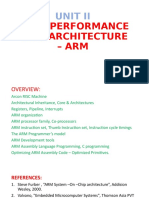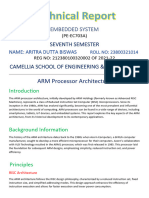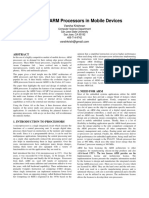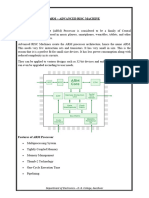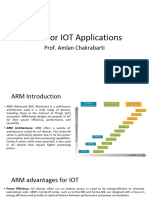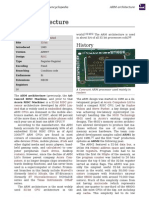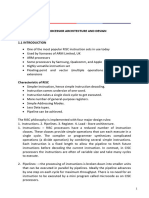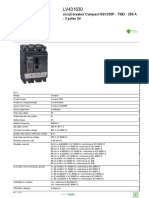Microprocessors & Microcontrollers
Second Year
Electrical Engineering Department
College of Engineering
Basrah University
2024-2025
5: ARM Processor
�ARM Processor
• An ARM processor is one of a family of CPUs based on the RISC (reduced instruction set
computer) architecture developed by Advanced RISC Machines (ARM).
• ARM makes 32-bit and 64-bit RISC multi-core processors. RISC processors are designed
to perform a smaller number of types of computer instructions so that they can operate at a
higher speed, performing more millions of instructions per second (MIPS). By stripping out
unneeded instructions and optimizing pathways, RISC processors provide outstanding
performance at a fraction of the power demand of CISC (complex instruction set
computing) devices.
2
�• ARM processors are extensively used in consumer electronic devices such as smartphones,
tablets, multimedia players and other mobile devices, such as wearables. Because of their
reduced instruction set, they require fewer transistors, which enables a smaller die size for the
integrated circuitry (IC).
• The ARM processor’s smaller size, reduced complexity and lower power consumption makes
them suitable for increasingly miniaturized devices.
ARM processor features include:
• Load/store architecture.
• An orthogonal instruction set.
• Mostly single-cycle execution.
• Enhanced power-saving design.
• 64 and 32-bit execution states for scalable high performance.
• Hardware virtualization support.
3
�• The simplified design of ARM processors enables more efficient multi-core processing and easier
coding for developers. While they don't have the same raw compute throughput as the products of
x86 market leader Intel, ARM processors sometimes exceed the performance of Intel processors for
applications that exist on both architectures.
• The head-to-head competition between the vendors is increasing as ARM is finding its way into
full size notebooks. Microsoft, for example, offers ARM-based versions of Surface computers. The
cleaner code base of Windows RT versus x86 versions may be also partially responsible. Windows
RT is more streamlined because it doesn’t have to support a number of legacy hardware.
• ARM is also moving into the server market, a move that represents a large change in direction and
a hedging of bets on performance-per-watt over raw compute power. AMD offers 8-core versions
of ARM processors for its Opteron series of processors. ARM servers represent an important shift
in server-based computing. A traditional x86-class server with 12, 16, 24 or more cores increases
performance by scaling up the speed and sophistication of each processor, using brute force speed
and power to handle demanding computing workloads.
• In comparison, an ARM server uses perhaps hundreds of smaller, less sophisticated, low-power
processors that share processing tasks among that large number instead of just a few higher-
capacity processors. This approach is sometimes referred to as “scaling out,” in contrast with the
“scaling up” of x86-based servers.
4
�ARM registers
ARM processors provide general-purpose and special-purpose registers. Some additional
registers are available in privileged execution modes.
In all ARM processors, the following registers are available and accessible in any processor
mode:
▪ 13 general-purpose registers R0-R12.
▪ One Stack Pointer (SP).
▪ One Link Register (LR).
▪ One Program Counter (PC).
▪ One Application Program Status Register (APSR).
• ARM processors, with the exception of ARMv6-M and ARMv7-M based processors, have a total
of 37 registers, with 3 additional registers if the Security Extensions are implemented, and in
ARMv7-A only, 3 more if the Virtualization Extensions are implemented.
• The registers are arranged in partially overlapping banks. There is a different register bank for each
processor mode. The banked registers give rapid context switching for dealing with processor
exceptions and privileged operations.
5
�Is Arm better than Intel x86?
• Not necessarily. Both types of processor architecture have their own strengths and weaknesses. The
excellent power consumption and heat dissipation makes Arm a great fit for small, portable devices
such as smartphones and tablets.
• Meanwhile, Intel’s x86 CISC (complex instruction set computer) architecture has been traditionally
better suited for performance-focused tasks as it can carry out more complex instructions per clock.
This made them a natural fit for laptops and desktop PCs, which generally see heavier workloads
than the likes of smartphones and tablets.
• Laptop manufacturers have previously snubbed Arm-based chips as they require huge amounts of
RAM and suffer compatibility issues with the Windows operating systems, but that’s all looks to be
gradually changing. Now RAM is a lot more affordable, and Microsoft is working with Qualcomm
to address those compatibility issues.
• We’re now at a stage where manufacturers are selling laptops equipped with Arm-based chips,
including Samsung’s Galaxy Book S, Lenovo’s Yoga C630 13 and Microsoft’s Surface Pro 9 5G.
These laptops flaunt above-average battery life, new ultra-portable designs and support for LTE
connectivity, and while the CPU performances weren’t quite as good as Intel x86 counterparts,
they were still easily powerful enough for basic tasks such as web browsing, video streaming and
word processing.
6
�H.W
Write a report about the following title:
Massively Parallel processing on ARM Processor












